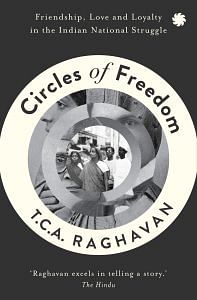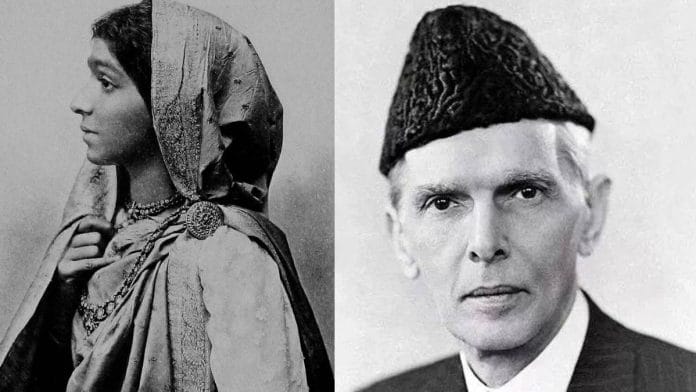Sarojini had been associated with the Indian national movement for some years, had addressed nationalist public meetings and ably demonstrated her powers of oratory. To her, India’s emergent nationalism was a renaissance of the nation to be, no less. Being in Sarojini’s inner circle therefore went beyond the literary and the aesthetic. In particular, this led to a closer acquaintance with another star of the Indian diaspora in England who was also already a leading figure in India, Muhammad Ali Jinnah.
Asaf had first met Jinnah at around this time in 1913 or early 1914 at the National Liberal Club, a favourite haunt of both. Asaf later recalled that Jinnah’s reserve then was ‘not a thousandth part as freezing as it has now become. He was a stickler for principles, transparently honourable and genial.’ Jinnah was already friends with Sarojini, an ‘enviably close friendship’, Asaf called it.
They had met in 1906 at the Calcutta session of the Indian National Congress which had as its backdrop the 1905 partition of Bengal that revived the organization but also led to its first great split. Sarojini was to describe Jinnah as being then ‘a rising lawyer and a coming politician’ and one who, fired by ‘virile patriotism’, had long been part of the National Congress and regularly attended its annual gatherings. Perhaps Asaf saw Jinnah then, as no doubt many other young men would have, as a model for a career path. Jinnah was at home in both England and India; he was a polished speaker, someone with a formidable reputation at the Bar; he was a liberal, not wedded to religious dogma and above the Hindu–Muslim compartments into which many others divided their public lives.
Finally, he was someone who spoke his mind without equivocation. While Jinnah and Syud were important in Asaf’s life at this point, Sarojini was more significant. Asaf Ali had never met a woman like her before and nothing in his social experience in Delhi or London had prepared him for the encounter. His life in Delhi was socially restricted when it came to interacting with women not closely related. London was obviously different but here the novelty was to occasionally meet young Englishwomen. An Indian woman at ease with the opposite sex – both among her compatriots and the English – was something new and unusual. Moreover, if Sarojini also realized how very unusual she was, she carried this knowledge lightly.
Sarojini, Asaf wrote, ‘quoted your favourite poets for you in her lyrical voice and with a tilt and rhythm which sounded pleasant to the ear even if somewhat un-English’. She was like ‘a breathing anthology . . . Anecdotes and humorous stories dovetailed into one another . . .’ Sarojini was moreover more than just a literary person. She was active in public life in India; she had a large circle of friends and acquaintances, and finally, she was genuinely interested in him as a person.
Also read:
These were reactions she evoked through most of her life in most people she came in contact with. Syud, Sarojini, Jinnah and Asaf sometimes formed a quartet. In the recollection of a younger contemporary, Hosain Ali Khan, a student in Oxford from Hyderabad and therefore well known to Sarojini, the four would meet at the National Liberal Club and then ‘would go for an aperitif to the Café Royal, and thence to the Monico nearby but more usually to some Soho restaurant for dinner . . .’ These evenings would end at ‘either Syud Hossain’s rooms at Holborn or Asaf Ali’s in West Kensington talking till the small hours of the morning’. Sarojini was at the centre of such gatherings and she certainly liked being surrounded by a court.
The picture that emerges of the young Asaf is of someone trying hard to fit into the cosmopolitan set he found himself in, a universe away from the Old Delhi haveli he grew up in. He was trying to be at ease in a set to which he aspired but in which he still felt he was an outsider. Perhaps meeting Sarojini gave him the first sense of life on a larger stage. But others saw it differently.
On one occasion Sarojini was invited to Oxford, and Syud and Asaf went with her. Hosain Ali Khan as a student of the university was tasked to show them around and he remembered being embarrassed as a young undergraduate ‘walking the streets of Oxford with two sophisticated gentlemen from London, dressed in the height of fashion – well cut, well-pressed lounge suits, fancy waistcoats, butterfly collars, foulard bow ties and bandana silk handkerchiefs shyly peeping out of breast pockets’.
Asaf was so grateful for all the horizons Sarojini had opened up for him in London that he decided to hold a reception in her honour, organizing it with the help of Syud and others. Needing a main speaker, he wrote to a number of prominent British poets. W.B. Yeats agreed and after that, it was plain sailing. Including the Indian guests, ‘covers were laid for more than 250’, he noted happily. Asaf’s only disappointment was the meagre coverage in the mainstream British press, which he attributed to not enough champagne being served to the journalists present. Nevertheless, for him, ‘the flashlight photograph of the dinner, our table plan and menu with the toast list and the letters and autographs of literary personalities of the day are among my treasure of mementos’.
Sarojini’s health was always a factor through her stay; she was soon run down given the hectic pace she maintained. Admitted to a nursing home, in no time she was receiving her countless friends, and Asaf found the ‘nurses on a verge of a breakdown, carrying flowers sent or brought by friends, guiding visitors, finding vases for flowers and looking after them no less than their ungovernable patient’. Her room, noted Asaf, was like a florist’s shop, with the same strong scents, and the ‘doctor’s instructions had been flouted to extinction’. But literary soirees and frantic socializing were not the only aspects of Asaf’s life in London that were galvanized by Sarojini’s presence.
Inevitably, perhaps, Asaf’s bachelor status would crop up and he writes about how a ‘potentially big event of my life suddenly crystallized out of the transparent air like mountain dew’. Sarojini announced the arrival of Liaq, a beautiful girl from one of the elite families of her home town, Hyderabad, who was in London under her chaperonage and on the lookout for a possible groom. ‘Sarojini was full of praises of the girl’s looks, training and family background and told me that she had a receptive mind still awaiting formation. Why should I not take my chance, if I was not wedded to bachelorhood?’ The idea of Liaq as a potential bride ‘was a stimulating suggestion’. This was as romantic as he could hope for, ‘if I was to marry an Indian girl; in the Muslim society of that time in India I could not hope even to catch sight of one prior to marriage’.
His family’s background in Kucha Chelan in Darya Ganj in Old Delhi would certainly rule out even the remote possibility of meeting and getting to know someone before a marriage was contemplated. Other suitors for Liaq (or so some of her relatives hoped) also included M.A. Jinnah. The formidable Sarojini would engineer a meeting with Jinnah as well, although, in Asaf ’s recollection, she did not think that Jinnah’s being interested in Liaq was a feasible idea.
 This excerpt from TCA Raghavan’s ‘Circles of Freedom: Friendship, Love and Loyalty in the Indian National Struggle’, has been published with permission from Juggernaut Books.
This excerpt from TCA Raghavan’s ‘Circles of Freedom: Friendship, Love and Loyalty in the Indian National Struggle’, has been published with permission from Juggernaut Books.






